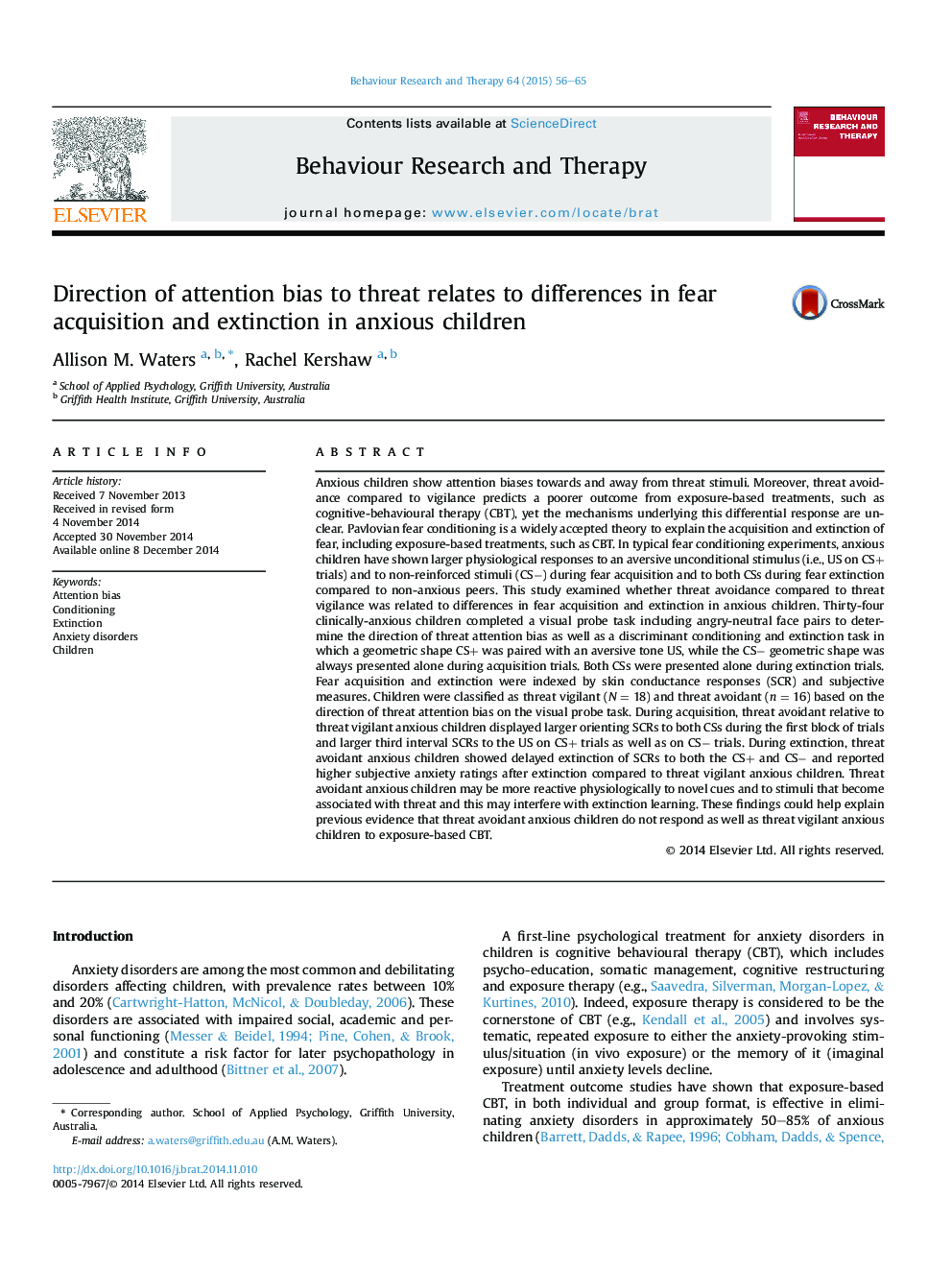| کد مقاله | کد نشریه | سال انتشار | مقاله انگلیسی | نسخه تمام متن |
|---|---|---|---|---|
| 7262497 | 1472785 | 2015 | 10 صفحه PDF | دانلود رایگان |
عنوان انگلیسی مقاله ISI
Direction of attention bias to threat relates to differences in fear acquisition and extinction in anxious children
ترجمه فارسی عنوان
جهت تعجب توجه به تهدید به تفاوت در ترس و در نتیجه از بین رفتن در کودکان مضطرب است
دانلود مقاله + سفارش ترجمه
دانلود مقاله ISI انگلیسی
رایگان برای ایرانیان
کلمات کلیدی
تعصب توجه، تهویه مطبوع، انقراض، اختلالات اضطرابی، فرزندان،
موضوعات مرتبط
علوم پزشکی و سلامت
پزشکی و دندانپزشکی
روانپزشکی و بهداشت روانی
چکیده انگلیسی
Anxious children show attention biases towards and away from threat stimuli. Moreover, threat avoidance compared to vigilance predicts a poorer outcome from exposure-based treatments, such as cognitive-behavioural therapy (CBT), yet the mechanisms underlying this differential response are unclear. Pavlovian fear conditioning is a widely accepted theory to explain the acquisition and extinction of fear, including exposure-based treatments, such as CBT. In typical fear conditioning experiments, anxious children have shown larger physiological responses to an aversive unconditional stimulus (i.e., US on CS+ trials) and to non-reinforced stimuli (CSâ) during fear acquisition and to both CSs during fear extinction compared to non-anxious peers. This study examined whether threat avoidance compared to threat vigilance was related to differences in fear acquisition and extinction in anxious children. Thirty-four clinically-anxious children completed a visual probe task including angry-neutral face pairs to determine the direction of threat attention bias as well as a discriminant conditioning and extinction task in which a geometric shape CS+ was paired with an aversive tone US, while the CSâ geometric shape was always presented alone during acquisition trials. Both CSs were presented alone during extinction trials. Fear acquisition and extinction were indexed by skin conductance responses (SCR) and subjective measures. Children were classified as threat vigilant (N = 18) and threat avoidant (n = 16) based on the direction of threat attention bias on the visual probe task. During acquisition, threat avoidant relative to threat vigilant anxious children displayed larger orienting SCRs to both CSs during the first block of trials and larger third interval SCRs to the US on CS+ trials as well as on CSâ trials. During extinction, threat avoidant anxious children showed delayed extinction of SCRs to both the CS+ and CSâ and reported higher subjective anxiety ratings after extinction compared to threat vigilant anxious children. Threat avoidant anxious children may be more reactive physiologically to novel cues and to stimuli that become associated with threat and this may interfere with extinction learning. These findings could help explain previous evidence that threat avoidant anxious children do not respond as well as threat vigilant anxious children to exposure-based CBT.
ناشر
Database: Elsevier - ScienceDirect (ساینس دایرکت)
Journal: Behaviour Research and Therapy - Volume 64, January 2015, Pages 56-65
Journal: Behaviour Research and Therapy - Volume 64, January 2015, Pages 56-65
نویسندگان
Allison M. Waters, Rachel Kershaw,
